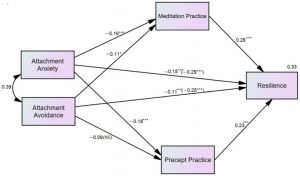Improve Secure Attachment and Resilience in Adolescents with Meditation
By John M. de Castro, Ph.D.
“meditation for teens. The practise of meditation will help you to let go of what is out of your control. To lessen the negative and draining energy of worry and anxiety.” – Tejay Dowe
Adolescence is a time of mental, physical, social, and emotional growth. But adolescence can be a difficult time, fraught with challenges. During this time the child transitions to young adulthood; including the development of intellectual, psychological, physical, and social abilities and characteristics. There are so many changes occurring during this time that the child can feel overwhelmed and unable to cope with all that is required. This can lead to emotional and behavioral problems.
Indeed, up to a quarter of adolescents suffer from depression or anxiety disorders, and an even larger proportion struggle with subclinical symptoms. Mindfulness training in adults has been shown to reduce anxiety and depression levels and improve resilience and emotional regulation. In addition, in adolescents it has been shown to improve emotion regulation and to benefit psychological and emotional health.
In today’s Research News article “Meditation and Five Precepts Mediate the Relationship between Attachment and Resilience.” (See summary below or view the full text of the study at: https://www.ncbi.nlm.nih.gov/pmc/articles/PMC8947555/ ) DeMaranville and colleagues recruited 10th – 12th grade students and had them complete measures of attachment anxiety, attachment avoidance, positive behavioral characteristics, precept practice, and resilience.
They found that the higher the levels of both attachment anxiety and attachment avoidance the lower the levels of resilience and the higher the levels meditation and precept practices the higher the levels of resilience. They also found that attachment anxiety was negatively associated with resilience by being negatively associated with meditation and precept practices.
Resilience is very important during adolescence where adversity can derail the individuals social/emotional/psychological development. The results of the current study suggest that an adolescent’s inability to bond with other human beings (insecure attachment) lowers the adolescent’s ability to adapt to adversity (resilience). But meditation and precept practices improve that adaptability. Finally, the results suggest that insecure attachment is associated with lower levels of meditation and precept practices resulting in less facilitation of resilience.
So, poor ability to bond with others reduces adolescents’ adaptability while meditation increases adaptability.
“Mindfulness offers teens a sense of control over their emotions and circumstances and will help them experience more joy because they are more focused on the present moment instead of worrying about past or future stress.” – Erin VanLuven
CMCS – Center for Mindfulness and Contemplative Studies
This and other Contemplative Studies posts are also available on Twitter @MindfulResearch
Study Summary
DeMaranville, J., Wongpakaran, T., Wongpakaran, N., & Wedding, D. (2022). Meditation and Five Precepts Mediate the Relationship between Attachment and Resilience. Children (Basel, Switzerland), 9(3), 371. https://doi.org/10.3390/children9030371
Abstract
Secure attachment is fundamental to the development of resilience among adolescents. The present study investigated whether meditation and precept practices influence the relationship between attachment and resilience. This study recruited 453 10th–12th-grade boarding school students who completed the Experience of Close Relationship Questionnaire (revised), Resilience Inventory, Inner Strength-Based Inventory, and Precept Practice to assess attachment, resilience, meditation practice, and precepts adherence. The participants’ mean age was 16.35 ± 0.96 years; 87.9% were females, and 89.2% were Buddhists. A parallel mediation model within the structural equation framework was used for an analysis of the indirect effect of attachment on resilience through meditation and precept practices. The indirect effects of attachment anxiety and avoidance on resilience were β = −0.086, 95% CI = −0.125, −0.054, p < 0.001, and β = −0.050, 95% CI = −0.088, −0.021, p = 0.006, respectively. The indirect effect size resulting from meditation was significantly higher than that resulting from observance of the precepts. The parallel mediation model explained the 33% variance of the resilience scores, compared with 23% from the direct effect of attachment anxiety and avoidance only. This work provides evidence that meditation and precepts significantly affect the relationship between attachment and resilience.
https://www.ncbi.nlm.nih.gov/pmc/articles/PMC8947555/









